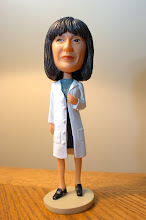 Wow this Sunday is Easter; its hard to believe how early it is this year. So, let me get right to this week's topic - Eggs. Christians are not the only ones who have ties to the egg during this season; Jews and Persians also use eggs as symbols during the spring. The egg symbolizes new life, a new beginning. It is why it is used to symbolize the resurrection of Jesus on Easter, new life and the Passover sacrifice at the Passover Seder, and the new year which begins at the spring equinox during Persian Nowrooz. Given that the egg holds such a place of honor, I thought it deserving of a little blog time.
Wow this Sunday is Easter; its hard to believe how early it is this year. So, let me get right to this week's topic - Eggs. Christians are not the only ones who have ties to the egg during this season; Jews and Persians also use eggs as symbols during the spring. The egg symbolizes new life, a new beginning. It is why it is used to symbolize the resurrection of Jesus on Easter, new life and the Passover sacrifice at the Passover Seder, and the new year which begins at the spring equinox during Persian Nowrooz. Given that the egg holds such a place of honor, I thought it deserving of a little blog time.The egg is a marvel of engineering, not to mention a pretty amazing piece of nutrition. Let's start from the inside out. The yolk, as the source of nutrition in a fertilized egg for the developing chick, is a rich source of calories from fat, iron, phosphorous, calcium, vitamin A, some of the vitamin Bs, and vitamin D. It also contains lecithin, a natural emulsifier. The yolk is suspended inside the egg by the chalazae - the opaque white "ropes" you see in the egg whites. The egg whites are more correctly termed the albumin (from the latin albus meaning white) and are not homogeneous. There are four alternating layers of thick and thin albumin and there are multiple proteins that comprise the egg albumin. These different albumin proteins all have different coagulation temperatures, which we will get back to in a bit. Between the albumin and the shell are two membranes and between those two membranes is an air cell. Last but not least is the shell, a mix of calcium carbonate, magnesium carbonate and calcium phosphate. While it looks solid, it actually has around 17,000 pores which make it semi-permeable and allow air and moisture to migrate in and out of the shell.
But before you can decorate all of those eggs for Easter, you'll have to hard-cook them. You'll notice I didn't say hard-boil them, that is because boiling eggs is a really bad idea. The different albumin proteins start to coagulate (cook) at 145°F with the last proteins coagulating at 183°F and the yolk coagulates around 160-165 °F, so the boiling temperature of 212°F is way too high. Boiling will over cook both the albumin, causing the whites to be tough and rubbery, and the yolk causing it to be dry and mealy. The temperature of the water should never be above a bubble-less simmer of 180-185°F and the eggs, depending on their size, should not need to be cooked for more than 10-15 minutes.
I also recommend starting your cooking with room temperature eggs placed into cold water and adding salt and a teaspoon to tablespoon (depends on how many eggs you are cooking) of vinegar. The salt & vinegar help to coagulate any albumin that may leak out of hairline cracks in the shell and help to prevent the green-gray ring that sometimes is seen around the yolk. That ring happens when the hydrogen sulfide gas (produced from the sulfur in the amino acids) from the albumin reacts with the iron in the yolk to create ferrous sulfide. Adjusting the pH of the solution of the water via the vinegar reduces the production of the hydrogen sulfide gas, and thus the potential for the green ring. The last thing is getting them immediately into a bowl of ice water once they are done cooking; keep them immersed in the ice water, adding more ice if necessary, for 15-20 minutes. This will both help prevent the green ring, and shrink the cooked egg away from the shell so they are easier to peel. Once you have your hard-cooked eggs, they should be refrigerated, where they will last easily for one week.
I hope you enjoyed this piece on the egg, and that whatever holiday you celebrate in the spring, that it is wonderful and an expression of the bounties of life that make this time of year so special!






No comments:
Post a Comment